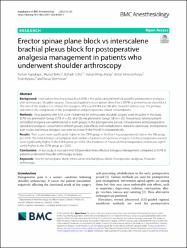| dc.contributor.author | Kapukaya, Furkan | |
| dc.contributor.author | Ekinci, Mürsel | |
| dc.contributor.author | Çiftçi, Bahadır | |
| dc.contributor.author | Atalay, Yunus Oktay | |
| dc.contributor.author | Gölboyu, Birzat Emre | |
| dc.contributor.author | Kuyucu, Ersin | |
| dc.contributor.author | Demiraran, Yavuz | |
| dc.date.accessioned | 2022-05-27T07:59:17Z | |
| dc.date.available | 2022-05-27T07:59:17Z | |
| dc.date.issued | 2022 | en_US |
| dc.identifier.citation | Kapukaya, F., Ekinci, M., Çiftçi, B., Atalay, Y. O., Gölboyu, B. E., Kuyucu, E. ... Demiraran, Y. (2022). Erector spinae plane block vs interscalene brachial plexus block for postoperative analgesia management in patients who underwent shoulder arthroscopy. BMC Anesthesiology, 22(1). https://doi.org/10.1186/s12871-022-01687-5 | en_US |
| dc.identifier.issn | 1471-2253 | |
| dc.identifier.uri | https://doi.org/10.1186/s12871-022-01687-5 | |
| dc.identifier.uri | https://hdl.handle.net/20.500.12511/9469 | |
| dc.description.abstract | Background Interscalene brachial plexus block (ISB) is the gold standard method used for postoperative analgesia after arthroscopic shoulder surgery. Ultrasound guided erector spinae plane block (ESPB) is an interfascial plane block. The aim of this study is to compare the analgesic efficacy of ESPB and ISB after shoulder arthroscopy. The primary outcome is the comparison of the perioperative and postoperative opioid consumptions. Methods Sixty patients with ASA score I-II planned for arthroscopic shoulder surgery were included in the study. ESPB was planned in Group ESPB (n = 30), and ISB was planned in Group ISB (n = 30). Intravenous fentanyl patient-controlled analgesia was administered to both groups in the postoperative period. Intraoperative and postoperative opioid and analgesic consumption of both groups, side effects and complications related to opioid use, postoperative pain scores and rescue analgesic use were recorded in the first 48 h postoperatively. Results Pain scores were significantly higher in the ESPB group in the first 4 h postoperatively than in the ISB group (p < 0.05). The total fentanyl consumption and number of patients using rescue analgesics in the postoperative period were significantly higher in the ESPB group (p < 0.05). The incidence of nausea in the postoperative period was significantly higher in the ESPB group (p < 0.05). Conclusions In our study, it was seen that ISB provided more effective analgesia management compared to ESPB in patients underwent shoulder arthroscopy surgery. | en_US |
| dc.language.iso | eng | en_US |
| dc.publisher | BMC | en_US |
| dc.rights | info:eu-repo/semantics/openAccess | en_US |
| dc.rights | Attribution 4.0 International | * |
| dc.rights.uri | https://creativecommons.org/licenses/by/4.0/ | * |
| dc.subject | Erector Spinae Plane Block | en_US |
| dc.subject | Interscalene Brachial Plexus Block | en_US |
| dc.subject | Postoperative Analgesia | en_US |
| dc.subject | Shoulder Arthroscopy | en_US |
| dc.title | Erector spinae plane block vs interscalene brachial plexus block for postoperative analgesia management in patients who underwent shoulder arthroscopy | en_US |
| dc.type | article | en_US |
| dc.relation.ispartof | BMC Anesthesiology | en_US |
| dc.department | İstanbul Medipol Üniversitesi, Tıp Fakültesi, Cerrahi Tıp Bilimleri Bölümü, Anesteziyoloji ve Reanimasyon Ana Bilim Dalı | en_US |
| dc.authorid | 0000-0002-3245-6614 | en_US |
| dc.authorid | 0000-0001-9928-9956 | en_US |
| dc.authorid | 0000-0003-0811-4945 | en_US |
| dc.identifier.volume | 22 | en_US |
| dc.identifier.issue | 1 | en_US |
| dc.relation.publicationcategory | Makale - Uluslararası Hakemli Dergi - Kurum Öğretim Elemanı | en_US |
| dc.identifier.doi | 10.1186/s12871-022-01687-5 | en_US |
| dc.institutionauthor | Kapukaya, Furkan | |
| dc.institutionauthor | Çiftçi, Bahadır | |
| dc.institutionauthor | Atalay, Yunus Oktay | |
| dc.institutionauthor | Demiraran, Yavuz | |
| dc.identifier.wos | 000794928100001 | en_US |
| dc.identifier.scopus | 2-s2.0-85130637263 | en_US |
| dc.identifier.pmid | 35550031 | en_US |
| dc.identifier.scopusquality | Q2 | en_US |



















